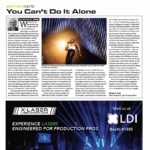There used to be a time when you designed your show around two types of moving lights — hard edge and wash fixtures. I grew up in a time where the hard beams were from Vari-Lites or lekos and the wash came from pars. The only color changing we saw was from color wheels and color scrollers on conventional fixtures.
In the late 80’s everything became about color mixing. There were epic clashes as rivals sued and counter-sued over who had the rights to use what dichroic glass system they had to make this possible. People filed for bankruptcy over color mixing.
But no matter who made the color systems, they rarely could snap to the next color as fast as a shutter could close on the same fixture. It didn’t matter that you had to turn off every other light on stage to see that fade from blue to red in order to see any light output, it looked cool. So color mixing became the norm for a whole new generation of programmers. The old-fashioned color wheel was often shunned by these same folks.
Tools vs. Skills
Along came the LED products and the advent of the instantaneous color change. No traditional color mixing system can keep up. Well, that is, unless you have learned to master the color wheel.
I hate hitting a color bump and watching my Vipers or Vari-Lites swap colors a half second after the LEDs have snapped. So a few things got me thinking about how we did things old school and how we can do them now. So I made a conscious decision along the same mindset of what I saw a couple of my friends were doing last year, and it made sense to follow their lead.
I saw Butch Allen design some lights for Carrie Underwood in the round. He needed a large number of hard edge fixtures, but had a budget. He went with a large amount of Chauvet Rogues that had color wheels only. The show looked great to me. I could never tell his main source of automated spots couldn’t mix color.
Last winter I saw the TSO show, always an over-the-top production. Bryan Hartley had a lot of toys. But what was his one main hard edge fixture? A lot of Robe Pointes. They don’t mix color either. Anyone notice?
I’m no longer very big on gobos in rock shows. I may pop one in for an audience scene or to aerial frame a stage look, but I’m happy with the old “dog paw” breakup 90 percent of the time. What I was in the market for was some good old-fashioned spots that could cut through video, open up to 20-40 degrees, have a simple prism, gobo and a snappy color wheel.
If I want to change color slowly for a show, I had a rig full of LED striplights, JDC1 strobe/wash fixtures that can bathe the stage in color and some Mac Auras for key lights. I chose a bunch of Robe Pointes, because they could zoom and I can rent two for the price of a single 1200-watt arc profile.
As I programmed the show I often found myself looking to see what color is next to the current one I’m using in the wheel. I often make the next lighting scene revolve around that color. I can snap it back and forth in time with the LEDs or roll it in over a few second count. This actually didn’t bother me one bit. Other than the fact that every manufacturer seems to put this useless No Color/Lavender dichroic color in their wheels, I’m okay with this method. Any slow fades to a saturated color are done with the LED fixtures.
So often I hear LD’s lament that they just can’t work with lights that do not color mix. I understand their dilemma. I may have been that person once upon a time. But I have deep feelings for Lee 119 and Lee 139, the most saturated of blues and greens. These colors rarely allow any fixture to emit enough lumens to be useful, when color mixed. Amazing how luxurious these colors appear from behind the color wheel.
I grasp budget concerns and the constant artist-that-wants-everything-for-nothing struggle. There needs to be a little give and take. So this year I’m giving up a few expensive light fixtures in exchange for more heads. And I’m paying for it in color wheels. I’m okay with that.
For Nook Schoenfeld’s introduction to the Oct. 2017 issue of PLSN, go to www.plsn.me/201710ednote.


